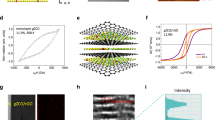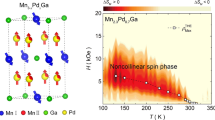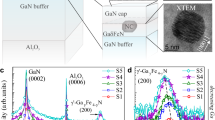Abstract
The emerging field of spintronics would be dramatically boosted if room-temperature ferromagnetism could be added to semiconductor nanostructures that are compatible with silicon technology. Here, we report a high-TC (>400K) ferromagnetic phase of (Ge,Mn) epitaxial layer. The manganese content is 6%, and careful structural and chemical analyses show that the Mn distribution is strongly inhomogeneous: we observe eutectoid growth of well-defined Mn-rich nanocolumns surrounded by a Mn-poor matrix. The average diameter of these nanocolumns is 3nm and their spacing is 10nm. Their composition is close to Ge2Mn, which corresponds to an unknown germanium-rich phase, and they have a uniaxially elongated diamond structure. Their Curie temperature is higher than 400K. Magnetotransport reveals a pronounced anomalous Hall effect up to room temperature. A giant positive magnetoresistance is measured from 7,000% at 30K to 200% at 300K and 9T, with no evidence of saturation.
This is a preview of subscription content, access via your institution
Access options
Subscribe to this journal
Receive 12 print issues and online access
$259.00 per year
only $21.58 per issue
Buy this article
- Purchase on Springer Link
- Instant access to full article PDF
Prices may be subject to local taxes which are calculated during checkout




Similar content being viewed by others
References
MacDonald, A. H., Schiffer, P. & Samarth, N. Ferromagnetic semiconductors: moving beyond (Ga,Mn)As. Nature Mater. 4, 195–202 (2005).
Zutic, I., Fabian, J. & Das Sarma, S. Spintronics: Fundamentals and applications. Rev. Mod. Phys. 76, 323–410 (2004).
Dietl, T. Ferromagnetic semiconductors. Semicond. Sci. Technol. 17, 377–392 (2002).
Timm, C. Disorder effects in diluted magnetic semiconductors. J. Phys. Condens. Matter 15, R1865–R1896 (2003).
Sato, K., Katayama-Yoshida, H. & Dederichs, P. H. High Curie temperature and nano-scale spinodal decomposition phase in dilute magnetic semiconductors. Jpn J. Appl. Phys. 44, L948–L951 (2005).
Ohno, H., Munekata, H., Penney, T., von Molnar, S. & Chang, L. L. Magnetotransport properties of p-type (In,Mn)As diluted magnetic III-V semiconductors. Phys. Rev. Lett. 68, 2664–2667 (1992).
Ohno, H. Making nonmagnetic semiconductors ferromagnetic. Science 281, 951–956 (1998).
Ferrand, D. et al. Carrier-induced ferromagnetism in p- Zn1−xMnxTe . Phys. Rev. B 63, 085201 (2001).
Jungwirth, T. et al. Prospects for high temperature ferromagnetism in (Ga,Mn)As semiconductors. Phys. Rev. B 72, 165204 (2005).
Park, Y. D. et al. A Group-IV ferromagnetic semiconductor MnxGe1−x . Science 295, 651–654 (2002).
Li, A. P., Shen, J., Thompson, J. R. & Weitering, H. H. Ferromagnetic percolation in MnxGe1−x dilute magnetic semiconductor. Appl. Phys. Lett. 86, 152507–152509 (2005).
Cho, S. et al. Ferromagnetism in Mn-doped Ge. Phys. Rev. B 66, 033303 (2002).
Pinto, N. et al. Magnetic and electronic transport percolation in epitaxial Ge1−xMnx films. Phys. Rev. B 72, 165203 (2005).
Tsui, F. et al. Novel germanium-based magnetic semiconductors. Phys. Rev. Lett. 91, 177203–177206 (2003).
Braak, H. et al. Magnetic characteristics of epitaxial Ge(Mn,Fe) diluted films-a new room temperature magnetic semiconductor? J. Magn. Magn. Mater. 286, 46–50 (2005).
Kang, J.-S. et al. Spatial chemical inhomogeneity and local electronic structure of Mn-doped Ge ferromagnetic semiconductors. Phys. Rev. Lett. 94, 147202 (2005).
Sugahara, S., Lee, K. L., Yada, S. & Tanaka, M. Precipitation of amorphous ferromagnetic semiconductor phase in epitaxially grown Mn-doped Ge thin films. Jpn J. Appl. Phys. 44, L1426–L1429 (2005).
Dormann, J. L., Fiorani, D. & Tronc, E. Advances in Chemical Physics (Wiley, New York, 1997).
Goswami, R. et al. Growth of ferromagnetic nanoparticles in Ge:Fe thin films. Appl. Phys. Lett. 86, 032509 (2005).
Goswami, R., Kioseoglou, G., Hanbicki, A. T., Jonker, B. T. & Spanos, G. Formation of Cr-germanide nanoparticles during growth of epitaxial Ge-Cr thin films. Acta Mater. 52, 2419–2427 (2004).
Park, Y. D. et al. Magnetoresistance of Mn:Ge ferromagnetic nanoclusters in a diluted magnetic semiconductor matrix. Appl. Phys. Lett. 78, 2739–2741 (2001).
D'Orazio, F. et al. Magnetooptical study of Mn ions implanted in Ge. IEEE Trans. Magn. 38, 2856 (2002).
Massalski, T. B. (ed.) Binary Alloy Phase Diagrams 2nd edn, Vol. 2, 1964 (American Society for Metals, Metals Park, Ohio, 1990).
Wachtel, E. & Henig, E.-T. Aufbau des systems mangan-germanium. Z. Metallkd. 60, 243–248 (1969).
Zhang, Y., Jiang, Q., Smith, D. J. & Drucker, J. Growth and characterization of Si1−xMnx alloys on Si(100). J. Appl. Phys. 98, 033512 (2005).
Schulthess, T. C. & Butler, W. H. Electronic structure and magnetic interactions in Mn doped semiconductors. J. Appl. Phys. 89, 7021–7023 (2001).
Beleggia, M., Tandon, S., Zhu, Y. & De Graef, M. On the magnetostatic interactions between nanoparticles of arbitrary shape. J. Magn. Magn. Mater. 278, 270–284 (2004).
Fruchart, O., Klaua, M., Bartel, J. & Kirschner, J. Self-organized growth of nanosized vertical magnetic Co pillars on Au(111). Phys. Rev. Lett. 83, 2769–2772 (1999).
Darques, M., Encinas, A., Vila, L. & Piraux, L. Tailoring of the c-axis orientation and magnetic anisotroy in electrodeposited Co nanowires. J. Phys. C 16, S2279–S2286 (2004).
Dietl, T., Ohno, H. & Matsukura, F. Hole-mediated ferromagnetism in tetrahedrally coordinated semiconductors. Phys. Rev. B 63, 195205 (2001).
Kossacki, P. et al. Spin engineering of carrier-induced magnetic ordering in (Cd,Mn)Te quantum wells. Physica E 21, 943–946 (2004).
Song, Y. P. et al. Physical origin of the ferromagnetic ordering above room temperature in GaMnN nanowires. J. Phys. C 17, 5073–5085 (2005).
Kazakova, O., Kulkarni, J. S., Holmes, J. D. & Demokritov, S. O. Room temperature ferromagnetism in Ge1−xMnx nanowires. Phys. Rev. B 72, 094415 (2005).
Sze, S. M. Physics of Semiconductors Devices (Wiley, New York, 1981).
Schklovskii, B. I. & Efros, A. L. Electronic Properties of Doped Semiconductors (Springer, Berlin, 1984).
Woodbury, H. H. & Tyler, W. W. Properties of germanium doped with manganese. Phys. Rev. 100, 659–662 (1955).
Solin, S. A., Thio, T., Hines, D. R. & Heremans, J. J. Enhanced room-temperature geometric magnetoresistance in inhomogeneous narrow-gap semiconductors. Science 289, 1530–1532 (2000).
Van Esch, A. et al. Interplay between the magnetic and transport properties in the III-V diluted magnetic semiconductor Ga1−xMnxAs . Phys. Rev. B 56, 13103–13112 (1997).
Golikova, O. A., Moizhes, B. Y. & Stilbans, L. S. Hole mobility of germanium as a function of concentration and temperature. Sov. Phys. Solid State 3, 2259–2265 (1962).
Berkowitz, A. E. et al. Giant magnetoresistance in heterogeneous Cu-Co alloys. Phys. Rev. Lett. 68, 3745–3748 (1992).
Akinaga, H. et al. Negative magnetoresistance in GaAs with magnetic MnAs nanoclusters. Appl. Phys. Lett. 72, 3368–3370 (1998).
Sawicki, M. et al. Influence of s-d exchange interaction on the conductivity of Cd1−xMnxSe:In in the weakly localized regime. Phys. Rev. Lett. 56, 508–511 (1986).
Shapira, Y., Oliveira, N. F., Becla, P. & Vu, T. Q. Magnetoresistance and Hall effect near the metal-insulator transition of n-type Cd0.95Mn0.05Te . Phys. Rev. B 41, 5931–5941 (1990).
Chazalviel, J.-N. Spin-dependent Hall effect in semiconductors. Phys. Rev. B 11, 3918–3934 (1975).
Author information
Authors and Affiliations
Corresponding author
Ethics declarations
Competing interests
The authors declare no competing financial interests.
Rights and permissions
About this article
Cite this article
Jamet, M., Barski, A., Devillers, T. et al. High-Curie-temperature ferromagnetism in self-organized Ge1−xMnx nanocolumns. Nature Mater 5, 653–659 (2006). https://doi.org/10.1038/nmat1686
Received:
Accepted:
Published:
Issue Date:
DOI: https://doi.org/10.1038/nmat1686
This article is cited by
-
Mn-doped SiGe thin films grown by UHV/CVD with room-temperature ferromagnetism and high hole mobility
Science China Materials (2022)
-
Ultrahigh-temperature ferromagnetism in MoS2 Moiré superlattice/graphene hybrid heterostructures
Nano Research (2021)
-
Effect of carbon on structural and magnetic properties of \(\hbox {Ge}_{1-x}\hbox {Mn}_{x}\) nanocolumns
Bulletin of Materials Science (2020)
-
Observation of Skyrmions at Room Temperature in Co2FeAl Heusler Alloy Ultrathin Film Heterostructures
Scientific Reports (2019)
-
Long-range magnetic interaction in Mn \(_{x}\) x Ge \(_{1-x}\) 1 - x : structural, spectromicroscopic and magnetic investigations
Journal of Materials Science (2017)



